Best Fly Fishing Boats: Catch More Fish With A Boat

As a river fishing guide, I spend over 100 days a year on what are known as fly fishing boats. These small water river boats are a great way to get my clients and me to water that we can’t get to on foot and they greatly increase the amount of fish we are able to target and catch.
But they are not just for guides because anyone can and should consider using one.
I have had the opportunity to try many different types of riverboats. I have also received good feedback from anglers, clients, and other guides about what fishing boats they are using.
Key Takeaways
- Boat Type: There are many options: inflatable boats, rafts, pontoon-style boats, or hard-bottomed boats like a skiff or a Jon boat. There are also stand-up boats that you can stand and fish from, and there are ones you can only sit on. Each has its own advantages and disadvantages.
- Safety: Rivers can be dangerous; some boats are safer than others. You do not want to put yourself at risk, so ensure you get a boat that is stable and safe.
- Price: Boats can run from a few hundred to over $5000.00.
I’ll provide my insights into why some boats are better than others and the pros and cons of fishing on these boats.
We may make a small commission from some of the links on this website, which is at no cost to you. I appreciate your support. Learn More
What Are Fly Fishing Boats?

Fly Fishing boats are small portable fishing boats that can be used by any angler who wants to fish a river, pond, or lake. They are meant for small water, are inexpensive, and are very mobile.
For my purposes, I prefer the stand-up pontoon boats and rafts because they are motorless, lightweight, durable, and the easiest to fish from.
Safety
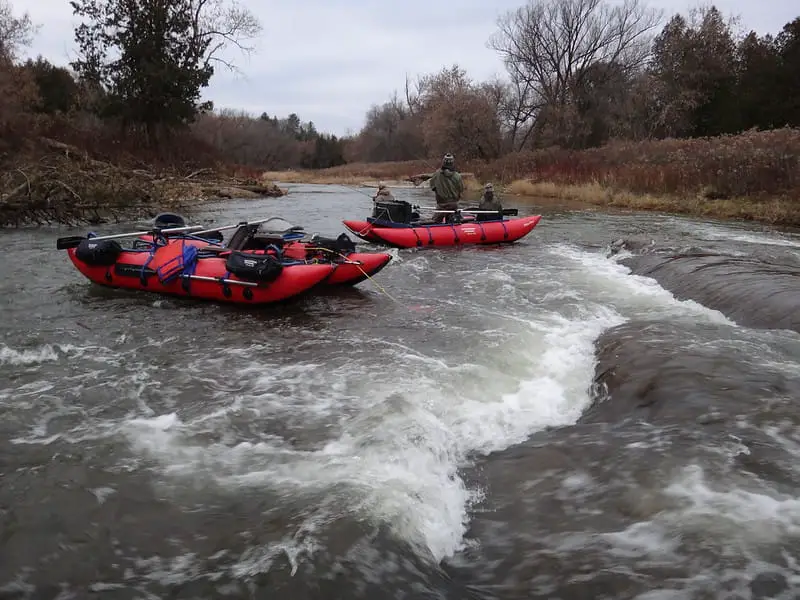
I bought my boats specifically for guiding purposes, and I needed durable and safe boats in fast and slow rivers. I also needed boats that were light enough to take them almost anywhere.
Safety is always my top priority when guiding..
I have tried sit-down and stand-up river fishing boats weighing anywhere from 20 pounds to about 150 pounds and I even fished out of some 400-pound drift boats.
Are Float Tubes Good For River Fishing
The only boats I do not recommend for river fishing are float tubes. Even though they are made for fishing, float tubes like the Wistar Inflatable Fishing Pontoon Float Tube and the Goplus Inflatable Fishing Float Tube are better for pond and lake fishing.
The issue I have with them in rivers is that with these types of boats, my feet are dangling in the water, and in fast currents, it’s possible that a foot or leg could get caught on a rock or log and pull me under. These boats also often do not have a paddle to maneuver, making them very dangerous in moving rivers.
The Best River Fishing Boats To Consider
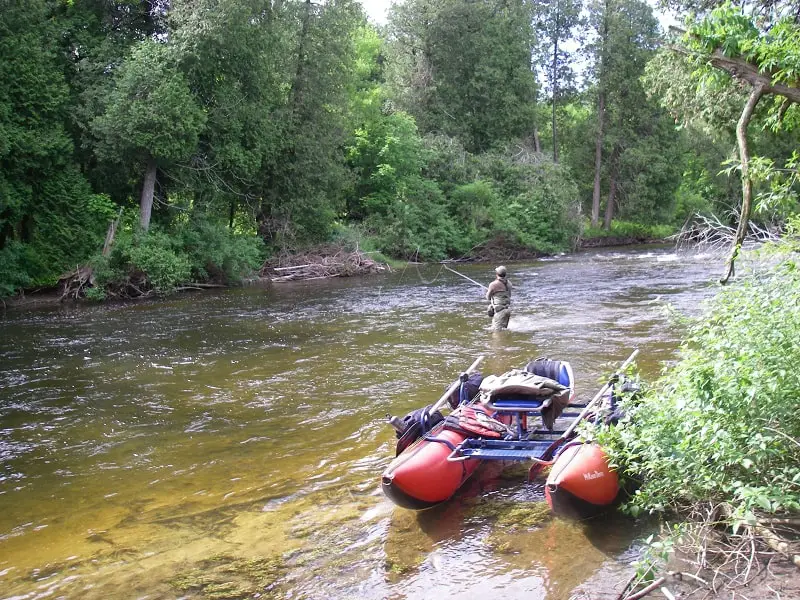
There are a number of different types of boats to consider. Some will be better and easier than others, depending on your situation and needs.
I prefer to use inflatable pontoon boats and inflatable rafts, but look at all the other boats to see what works best for you.
Inflatable Pontoon Boats
Inflatable pontoon boats are my favorite type of fly fishing boat, especially if they are made to allow the anglers to stand and fish. They are lightweight, durable, comfortable to sit in, and can go just about anywhere I can walk.
Some of the higher-quality boats are more durable than the cheaper ones, so for safety, get one that isn’t going to tear and pop when hitting rocks.
My boats have hit thousands of rocks stumps and have been dragged across the bottom with three heavy guys on it. I have even rammed them into the bank a few times and speared them with pointy logs, and they still barely have a scratch on them.
This is the kind of durability you want to be as safe as possible.
Good pontoon boats will ride higher than some of the cheaper boats, and with little gear and one guy on them, I can get through water less than four inches deep.
The wider and longer boats are more stable and will float higher.
One of the primary reasons I like these so much is that I can easily stand and put my feet on the ground to either stop and stabilize myself or move through or over tight or shallow water.
I have also found that standing in the middle makes it much easier to drag through the bush, around portages or log jams, and get to and from the vehicle.
There are two types of pontoon boats that you should consider: the sit-down-only pontoon boat and the stand-up pontoon boat.
Stand Up Fly Fishing Pontoon Boats
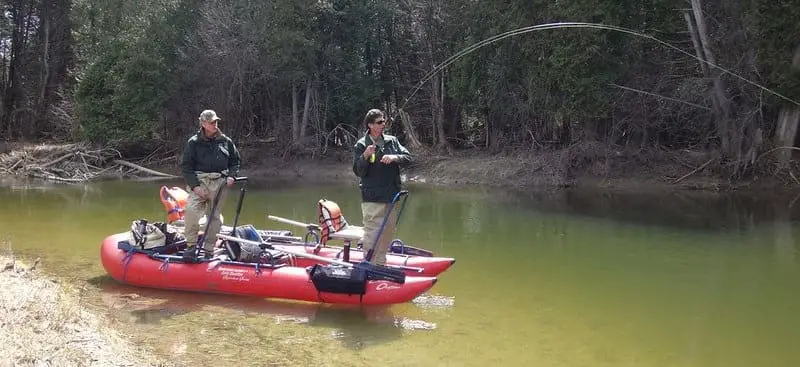
In my opinion, unless you need a super lightweight and packable boat, the stand-up boats are the best for river, pond, and lake fishing. With stand-up boats, you paddle sitting down but then stand up to fish.
Cheaper stand-up pontoon boats will tilt too much, but the better ones won’t tilt as much unless you are a very heavy angler. Longer and wider boats are best if you want a stand-up boat. Check the weight rating on the boat before you buy.
Some of the best standup boats are the Outlaw Avenger X and the Skykomish Sunrise.
The primary advantage of a stand-up pontoon boat is that I don’t even need to get out of the boat, and I can go for miles without getting my feet wet.
Some of my clients don’t even wear their waders anymore because my boat gets them to all the spots, and they don’t get their feet wet.
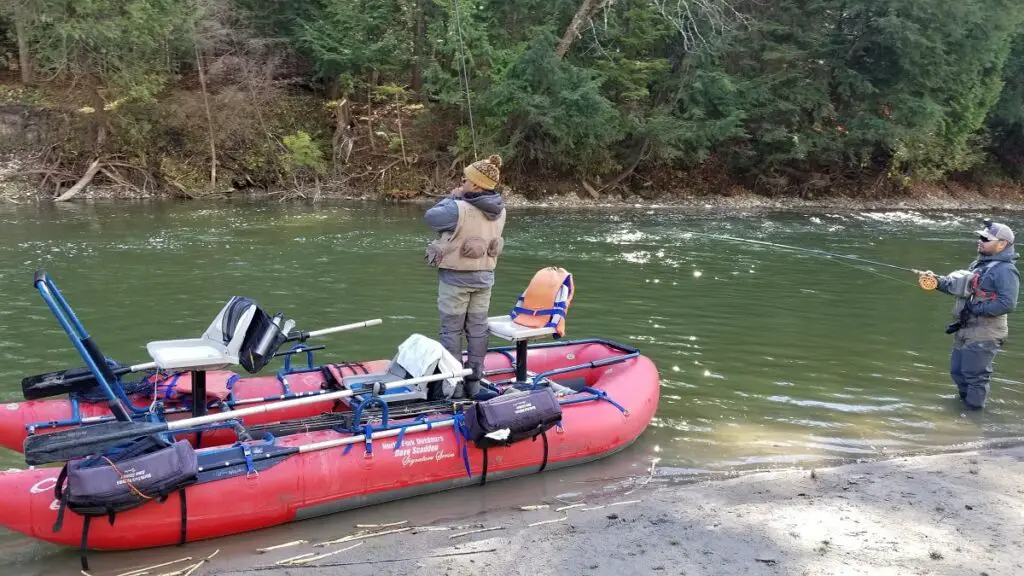
I will never need to trespass on rivers with lots of private property and on rivers where the river bottom is private because I never need to get out of the boat.
I can even set up a drag-chain anchor that slowly drags down the river so I can slowly fish as I go.
The main reason that I prefer stand-up river boats is that it is much easier to fish when standing up.
Casting and fighting fish is also easier when standing. Standing above the water also gives me a better view compared to sitting down.
The 3-man 15-foot boat in the picture is about 130 pounds, and it can be taken apart, and put into a goalie-sized hockey bag or thrown into the trunk of a car.
Sit-Down Pontoon Boats

If you need a super light boat that is packable or you are the type of angler who likes to get out at each spot, then sit-down pontoon boats are your best option.
With sit-down pontoon boats, I can stop the boat, anchor it where I am, stand up in the water, and start fishing with the boat at my side.
At the end of the day, these boats pack down so small that some can fit in a backpack, and the bigger ones will easily fit in a normal-sized hockey bag.
These are also great boats to travel with and can be checked in when flying. The three models above are good options because they are stable, durable, pack down into a bag, and can be carried in and out of the river easily.
The four boats I recommend are the Outcast Osg Commander, which weighs about 35 pounds, the Predator Lo Pro X which weighs about 10 pounds, the Outlaw Challenger which weighs about 45 pounds and the 2022 Raptor Lite Speed X which is just under 25 pounds.
The downside to a sit-down-only boat is that it’s much harder to fish sitting down. This only matters when on rivers or lakes where I can’t get out.
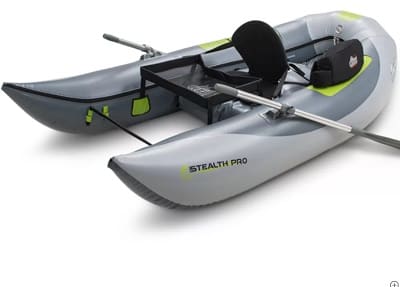
I always recommend boats where I can put my feet up.
Having my feet dangling in the water is dangerous in shallow faster moving rivers.
Trust me, I have come close and almost broke or twisted my leg when it got wedged between the bottom and the weight of the water pushing on the boat.
The other advantages to boats that I can keep my feet up is that I have more leverage on the oars, and I can get through much shallower water when my feet aren’t dragging.
Inflatable Rafts
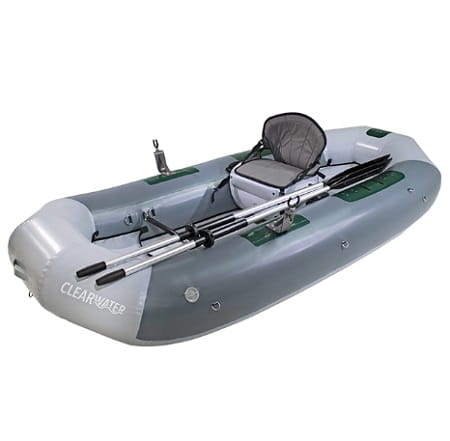
Inflatable river rafts are another type of fly fishing boat. These are a great option for anglers who fish in rivers, lakes, and ponds.
Fly fishing rafts come in all sizes and weights, as well as stand-up and sit-down models.
I do find that some fly fishing rafts are a little harder to maneuver, and they tend to drag a little more due to more surface area on the water than a pontoon boat, and they are harder to get in and out of.
Parking the boat near the bank to get out can be a little tougher in faster-moving water. Stabilizing myself in the middle of the river in a faster current can also be more difficult since rafts have a lot of drag on the bottom, and many anchors won’t hold well in currents.
With my pontoon boat, I can get close to the bank where I want to get out and then stand up and walk the boat to the bank. Being able to stand and hold the boat against the bank makes it easier and safer for my passengers to get on and off the boat.
I also find that there is more surface area that can get caught on rocks and sticks with a raft and that could cause more damage to the bottom of the boat. Pontoon boats take up less surface space on the water.
The single-man rafts can’t be used to stand on a fish out of like the stand-up pontoon boats can because they aren’t as stable.
However, inflatable rafts are still a good option. They are lots of fun and are a great way to get into water that not many guys can fish.
Just make sure you get a good one that is super durable and not meant for a swimming pool or a lake.
You want one that can withstand being dragged over rocks and logs and dragged to and from the vehicle.
Some of the best options for raft-style boats are the Outcast Clearwater, which weighs around 35 pounds, the Assault X R or the 2-man Assault XX R, or a stand-up like the Dragonfly XT1.
Dinghy Boats
Dinghy boats can be good small water inflatable boats, but remember that they are meant for lakes and not rivers and that could mean that they are not durable enough for rivers where you are hitting rocks and bottom often.
I would say that the advantage to dinghies is that you can put a gas-powered motor on it but you can also do that with some of the inflatable pontoon boats and rafts above.
Kayaks
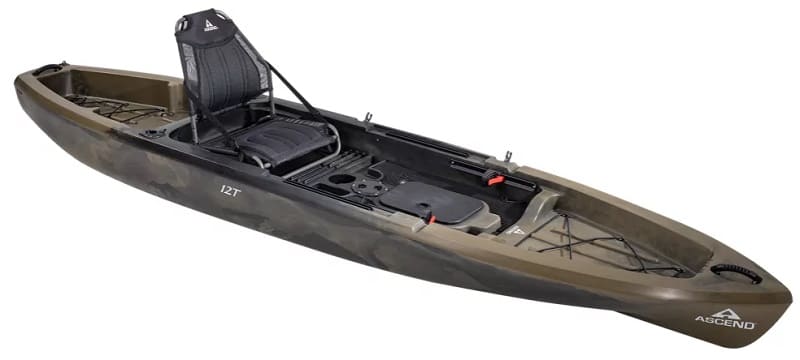
Kayaks can be a lot of fun and a great way to travel the river, but they can also be dangerous for new and unskilled boaters.
If you are interested in a Kayak to fly fish from, get one designed for fishing. These ones will make fishing easier with all the features and pockets for your gear and rods.
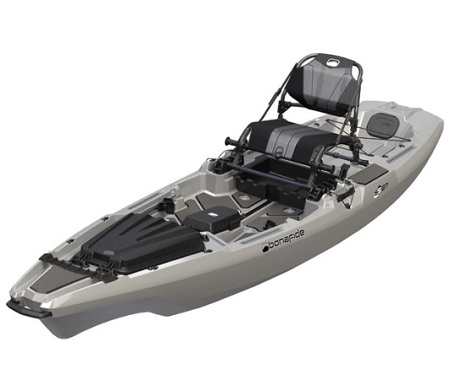
A good budget-freindly fishing Kayak to consider is the Ascend 128X Sit-On-Top Kayak, or for maximum stability, the Bonafide SS127 Sit-On-Top Fishing Kayak is a great option.
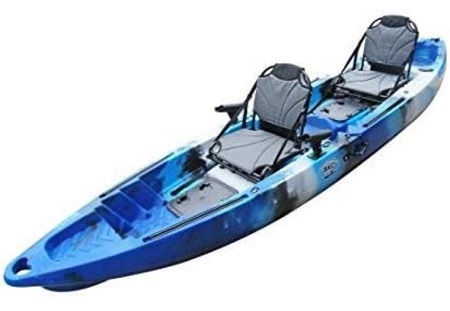
If you are looking for a two-person option, check out the BKC TK122U 12′ 6″ Tandem Kayak.
The BKC kayak is outfitted with a pair of ergonomic seats framed in aluminum, two adjustable paddles also made of aluminum, dual waterproof compartments, a quartet of built-in fishing rod holders, a pair of paddle storage spaces, and a single bungee system for cargo securement.
SPEAKING OF STABILITY: The BKC is carved from a single piece of high-density polyethylene through roto-molding. The BKC kayak outclasses inflatable counterparts in endurance and durability, ready for any setting – be it ocean, lake, or river and capable of bearing up to 770 lbs.
The 34-inch wide beam ensures the kayak remains steady even when faced with turbulent waters or rapid currents, offering exemplary stability for fishing in a variety of conditions.
Kayak Stability
Kayaks are unstable and can roll over easily if you do not know how to use them.
You do not want to be in a kayak in fast and shallow rapids when it rolls over on you. You could smash your face or your head and drown.
Kayak fishing in very cold water is also dangerous and fly fishing from them and fighting big fish can be challenging.
I have had some fun in Kayaks, but I don’t normally recommend kayaks for safety reasons, especially when the rafts and the pontoon boats are much better and safer boats in the rivers.
Canoes
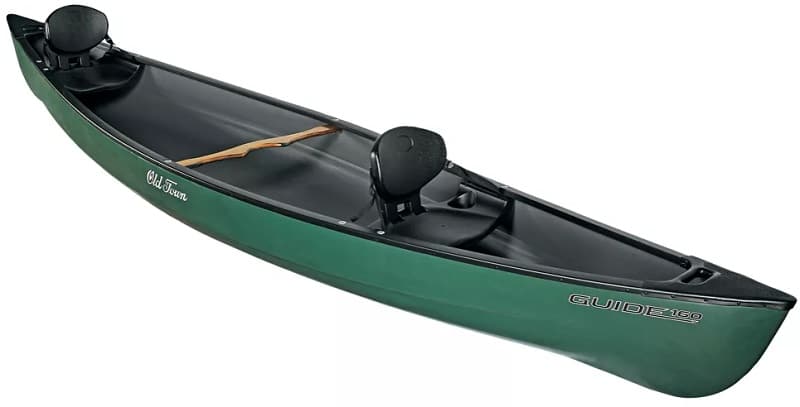
Canoes can be used as river fishing boats, but when you hit rocks, they bang hard so you will need to get a durable one.
Canoes are best used on lakes, ponds, and slower-moving rivers that are deeper than 8 inches.
Canoes can be unstable and hard to fish from which is why I do not recommend them on fast-flowing rivers. You can get some decent canoes shipped right to your door from Bass Pro Shops.
Hard Bottom Boats
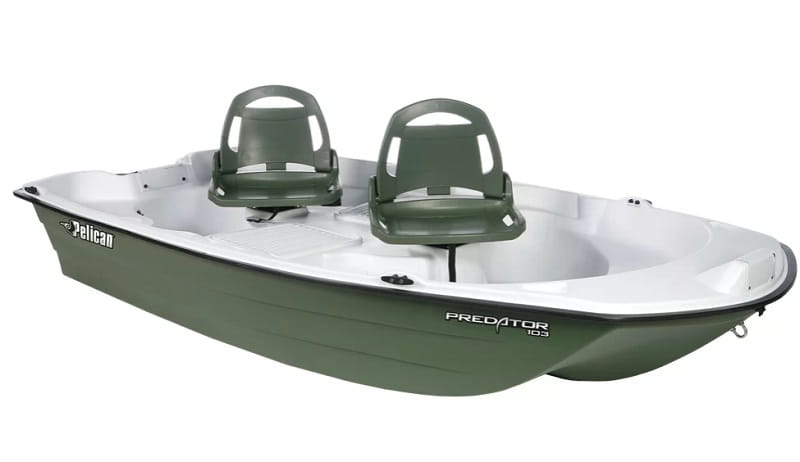
Hard-bottomed boats include Jon boats, drift boats, and rowboats. You could also use a basic aluminum boat that you would find on a lake.
These are not good in typical trout streams since they are heavy, hard to get in and out of the river, they hit bottom hard, and you can damage the boat on rocks.
If you want a boat like this, a couple of good options are the Pelican Predator 103 Fishing Boat, which weighs around 150 pounds.
Conclusion: River Fishing Boats
Without a doubt, one of my best methods that has enabled me, my buddies, and my clients, to catch more trout, catch more steelhead, and more salmon is to use boats like these that get us away from the crowd and get us into water that other anglers rarely or never fish.
I’ve figured out how to maximize the use of these boats on rivers so you can do it easily yourself or with a buddy. I discuss my tips and the advantages a river boat offers, which include seeing miles of new and almost untouched water, and catching a lot more fish. You can see all my tips at Guide Tips For Fishing Rivers From River Boats.
Tight Lines,
Graham

))/2164772.json)
Hey, Graham you mentioned a few things about anchors in this post I was just wondering if you know if it is legal to anchor on a river where the bottom of the river is private property or would this be considered trespassing. Thanks
Hey Liam,
That will depend on state and provincial laws. My guess is you are probably not permitted to anchor in spots where the landowner actually owns the river bottom so be careful with that.
I may talk about anchors and other boating strategies in a future post. Good luck.
Thanks a lot I’m in Ontario by the way!